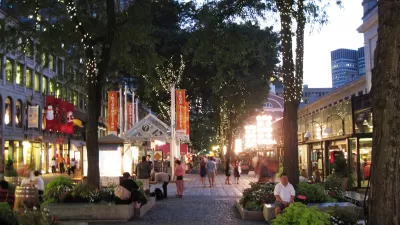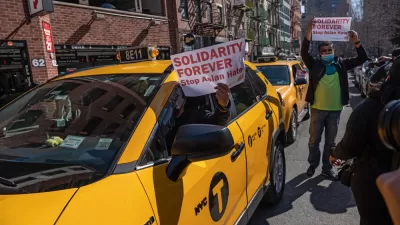Let's acknowledge that loneliness and depression is common among urban residents, and figure out ways urban planning can foster connections and social interactions between people.

It’s hard to believe someone could feel lonely surrounded by millions of people in an urban metropolis. But the truth is, loneliness affects residents of all ages in major cities.
Although there’s no single source of the feeling, there are plenty of reasons why urbanites report that they’re not as sociable as those living in sparsely populated locations. Almost as abundant are ways urban planners can make things less lonely for people in the future.
Why People Move to Cities
A 2016 report stated that two billion people would move to cities within the next 20 years.
Mass migration is nothing new — cities have become the epicenter of opportunity. Whether new residents seek work, education, healthcare, or social mobility, a metropolitan area is where they’re most likely to find it.
Despite all of the opportunities that come with living in these major cities, there are some drawbacks.
The problem is that a move to a big city means newcomers have to leave their social circles behind. Whether they're a few miles or several hours away from their family and childhood friends, life in the city can be a separation that makes these relationships feel the distance.
Plus, without the built-in sociability that comes with school or a career, it might be hard to meet people at first. There are steps to take to make more friends, of course, but the time between can be isolating.
How Living Alone Affects People
Another facet of city life that affects both young and old residents is the fact that so many urbanites live alone. In 1920, only five percent of people lived by themselves — compare that with the 27 percent of Americans who lived solo in 2016. That number has almost certainly risen in the years since.
Not everyone who lives alone is lonely, of course. Research shows that the quality of social interactions makes people feel more fulfilled, as opposed to the quantity.
So, even if someone spends most of their time in their studio apartment, they won’t feel a sense of loneliness if they grab dinner once a week with their best friend.
Without that interaction, though, they might feel more isolated.
Perhaps unsurprisingly, the age group most susceptible to this kind of loneliness is the elderly. That’s because as people age, social circles shrink. Think about it — as retirees, seniors no longer have daily interactions with colleagues.
They might watch as friends, family, and even spouses pass away. This type of loneliness can affect their health, too, so planning social gatherings with elderly family members who live alone can be beneficial to both of you.
Why Urban Transience Influences Urban Loneliness
Look at London as an example — by 2025, England’s capital should have about 60 percent of its residents renting property rather than owning it. Many other major cities have similar statistics — New York City was 51 percent renter-occupied in 2015 — which show just how transient the population is nowadays.
One of the main ones is that property comes with a hefty price tag, as does rent. In other words, city dwellers have a hard time saving up to buy property when they’re using all their income to pay for their current living quarters.
That’s why the census data mentioned above revealed that there were four times as many 30-year-old renters in New York City as there were 30-year-old property owners. Property ownership is just out of reach.
Without permanent residences, many urbanites eventually retreat to the suburbs, where they can live more comfortably. So, if a city dweller continually loses friends to the economically friendlier pastures of suburban life, they’re bound to feel lonely as their social circle shrinks with every moving truck that leaves the city.
How Urban Planners Can Help
It may seem as though the answer’s simple: make urban spaces more conducive to long-term living so people can live their entire lives in these communities. This type of a transformation will take years to complete, especially since the cost of living and real estate prices remain high in places like New York City.
In the interim, urban planners can use their position to encourage more social interaction among city dwellers who will fill the square miles they so carefully design. One great place to start is with green spaces.
There are already numerous health benefits that come with time spent outdoors, but an urban green area can be more than just a breath of fresh air. It can be a meeting place for those who live in the neighborhood, whether they’re first-time friends or have a long history together.
Urban planners can also bring the conveniences of these extra-large cities to smaller metropolises so that people have all the same opportunities and benefits of city living without leaving their home bases.
Adding public transport, bicycle lanes, and making public facilities more accessible by walking will give smaller cities that same convenient feel.
As a planner, you might feel as though you’ve provided all the tools to city residents so they can lead happy, social lives with their neighbors and friends. But sometimes, the most crowded places on Earth can be the loneliest.
Keep this in mind as you work. There’s plenty more that can be done to combat urban loneliness, and you could be the one to make a change with a few thoughtful planning choices.

Planetizen Federal Action Tracker
A weekly monitor of how Trump’s orders and actions are impacting planners and planning in America.

Maui's Vacation Rental Debate Turns Ugly
Verbal attacks, misinformation campaigns and fistfights plague a high-stakes debate to convert thousands of vacation rentals into long-term housing.

San Francisco Suspends Traffic Calming Amidst Record Deaths
Citing “a challenging fiscal landscape,” the city will cease the program on the heels of 42 traffic deaths, including 24 pedestrians.

Amtrak Rolls Out New Orleans to Alabama “Mardi Gras” Train
The new service will operate morning and evening departures between Mobile and New Orleans.

The Subversive Car-Free Guide to Trump's Great American Road Trip
Car-free ways to access Chicagoland’s best tourist attractions.

San Antonio and Austin are Fusing Into one Massive Megaregion
The region spanning the two central Texas cities is growing fast, posing challenges for local infrastructure and water supplies.
Urban Design for Planners 1: Software Tools
This six-course series explores essential urban design concepts using open source software and equips planners with the tools they need to participate fully in the urban design process.
Planning for Universal Design
Learn the tools for implementing Universal Design in planning regulations.
Heyer Gruel & Associates PA
JM Goldson LLC
Custer County Colorado
City of Camden Redevelopment Agency
City of Astoria
Transportation Research & Education Center (TREC) at Portland State University
Jefferson Parish Government
Camden Redevelopment Agency
City of Claremont






























